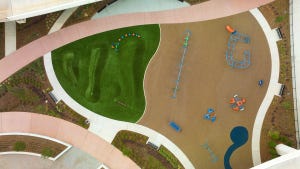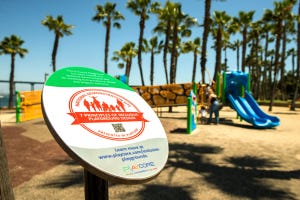 When I was nine years old I played little league baseball. I wasn’t the star athlete, but I enjoyed the camaraderie of being part of a team and I played each moment of each game as if it were “bottom of the ninth, bases loaded with two outs.” As much as I intensely enjoyed playing the game, I equally despised the weekly practices. No one kept score during a practice. There were no averages to maintain, errors to avoid or crowds to cheer. My coach frequently reminded me that practice was necessary in order for me to know how to play the game well. “Practice on Wednesday,” he would say each week, “is preparation for play on Saturday.” He was right, of course, but at the age of nine all I knew was practice was work. Playing was fun. You endured one in order to enjoy the other.
When I was nine years old I played little league baseball. I wasn’t the star athlete, but I enjoyed the camaraderie of being part of a team and I played each moment of each game as if it were “bottom of the ninth, bases loaded with two outs.” As much as I intensely enjoyed playing the game, I equally despised the weekly practices. No one kept score during a practice. There were no averages to maintain, errors to avoid or crowds to cheer. My coach frequently reminded me that practice was necessary in order for me to know how to play the game well. “Practice on Wednesday,” he would say each week, “is preparation for play on Saturday.” He was right, of course, but at the age of nine all I knew was practice was work. Playing was fun. You endured one in order to enjoy the other.
This was an axiom in my life, an incontrovertible truth that I could not avoid...until I began to research the subject of play.
Play is essential, and essentially overlooked
 It turns out that play is much more than playing baseball or skipping rope. It’s more than recess period at school or a trip to the playground. It is the only form of practice that prepares us, not for a game or a single event, but for the rest of our lives. It is hardwired into the evolutionary history of humankind and this kind of practice is even more enjoyable than what it prepares us for. Unfortunately, the lack of outdoor play and activity among American children has reached a level of crisis that is almost unfathomable.
It turns out that play is much more than playing baseball or skipping rope. It’s more than recess period at school or a trip to the playground. It is the only form of practice that prepares us, not for a game or a single event, but for the rest of our lives. It is hardwired into the evolutionary history of humankind and this kind of practice is even more enjoyable than what it prepares us for. Unfortunately, the lack of outdoor play and activity among American children has reached a level of crisis that is almost unfathomable.
In 2006, The American Academy of Pediatrics concluded in a clinical report, “The Importance of Play in Promoting Healthy Child Development and Maintaining Strong Parent-Child Bonds” by K.R. Ginsberg, that play is essential for cognitive, social and emotional development, health and well-being of children. The report found that an increased emphasis on academics, though important, had reduced the amount of time allowed for outdoor play and recess during school.
In 2010, the Henry J.Kaiser Foundation released a report, “Generation M2: Media in the Lives of 8-18 Year Olds,” that found children between the ages of 8-18 spend an alarming amount of time in front of a screen each day:
- Approximately 7.5 hours using entertainment media
- Approximately 4.5 hours watching TV
- Approximately 1.5 hours on the computer
- Over an hour playing video games
With statistics like these it is not surprising that the Centers for Disease Control and Prevention(1) today reports that:
- Childhood obesity has more than doubled in children and tripled in adolescents in the past 30 years
- More than one third of children and adolescents are overweight or obese.
- The percentage of children aged 6–11 years in the United States who were obese increased from 7% in 1980 to nearly 18% in 2010. Similarly, the percentage of adolescents aged 12–19 years who were obese increased from 5% to 18% over the same period.
 The effects of overweight and obesity in children are deleterious to their immediate and future health. Studies show that children who are overweight and obese are more likely to develop Type II diabetes and other conditions that lead to metabolic syndrome. They are also more likely to continue their poor dietary and exercise habits as adults and increase their risk factors for heart disease, heart attack and stroke.
The effects of overweight and obesity in children are deleterious to their immediate and future health. Studies show that children who are overweight and obese are more likely to develop Type II diabetes and other conditions that lead to metabolic syndrome. They are also more likely to continue their poor dietary and exercise habits as adults and increase their risk factors for heart disease, heart attack and stroke.
While a deficit of outdoor play and physical exercise presents serious concerns for a child’s physical well-being, there are other harms that are often overlooked. Children who eschew play in favor of sedentary activities are at risk of reducing their ability to be creative and to use their imagination.(2,3) They are at risk for losing their ability to interact in social settings and in resolving conflicts.(4,5) There is evidence that a lack of play in a child’s life can lead to felony behavior as an adult.(6)
If the cause of this epidemic is the couch and the playstation, the cure is the classroom and the playground.
Schools in America average 180 days of instruction per year. The CDC and the Department of Education estimate that elementary age children have recess for an average of 4.9 days per week. The daily recess time is between 24 and 30 minutes. That means for nearly half a year, American children have an opportunity to realize the benefits of outdoor play and physical activity at school. This is a tremendous opportunity for educators to make a vital and lasting impact on the lives of their students. While doctors, researchers, politicians and parents clamor to win the war on childhood obesity and play deficit, the secret weapon could be a teacher.
 The American Association for Physical Activity and Recreation (AAPAR) developed a successful toolkit called Play On!(7). In partnership with PlayCore, Inc. and a team of play experts from Louisiana State University, AAPAR created a curriculum and learning activity guide designed to promote physical activity on the playground. The Play On! Activity Guide meets National Association for Sport and Physical Education (NASPE) standards and provides teachers with 100 learning activities for grades K-5 that help children explore new ways to play: climbing, sliding, spinning, swinging, running, balancing, jumping and more. The activities also promote strength, endurance, flexibility and cardiovascular fitness for children of all abilities through the use of playground equipment.
The American Association for Physical Activity and Recreation (AAPAR) developed a successful toolkit called Play On!(7). In partnership with PlayCore, Inc. and a team of play experts from Louisiana State University, AAPAR created a curriculum and learning activity guide designed to promote physical activity on the playground. The Play On! Activity Guide meets National Association for Sport and Physical Education (NASPE) standards and provides teachers with 100 learning activities for grades K-5 that help children explore new ways to play: climbing, sliding, spinning, swinging, running, balancing, jumping and more. The activities also promote strength, endurance, flexibility and cardiovascular fitness for children of all abilities through the use of playground equipment.
With Play On!, teacher-led play can transform a playground into an outdoor physical education class. In most schools, P.E. classes are only taught once or twice a week, but Play On! creates an opportunity for children to benefit from a standards-based physical education curriculum every school day.
The benefits of coordinated, standards-based physical education on the playground are vast. Children who participate in activities like those found in the Play On! curriculum are more likely to live life at a healthy weight and avoid the health risks associated with childhood obesity. The rewards don’t stop at the waistline, however. There is evidence that play improves academic performance in the classroom.
The Archives of Pediatric and Adolescent Medicine (VU University in the Netherlands) reports(8) that physical activity leads to better academic performance, as measured by higher scores on standardized tests. Senior researcher Amika Singh reviewed 14 studies that considered physical activity as any exercise children received from either school-based P.E. classes or organized sports inside or outside of school. The studies showed that the more physical activity the children had, the higher their scores in school, particularly in the subjects of math, English and reading.
Time for practice
 Just as play leads to success in the classroom, play leads to success in life. Researchers who study the effects of play on the human brain have discovered that play enhances the centers of the brain that manage creativity and problem solving.
Just as play leads to success in the classroom, play leads to success in life. Researchers who study the effects of play on the human brain have discovered that play enhances the centers of the brain that manage creativity and problem solving.
Dr. Stuart Brown is a leader in play research. Trained in general and internal medicine, psychiatry and clinical research, he first discovered the importance of play by discerning its absence in the life of University of Texas Tower mass murderer, Charles Whitman. Throughout his clinical career, he’s interviewed thousands of people and captured their play profiles. He’s cataloged these profiles to demonstrate the negative consequences that inevitably accumulate in a play-deprived life. Conversely, he’s also identified how play contributes to the accomplishments of the very successful. During a recent conversation, Brown described play as “a method to assure optimal organization of intricate survival patterns, such as exploration and preparation for the unexpected.”
If there is one thing that is certain about life, it is full of the unexpected. When humans engage in play, the cerebral cortex is stimulated, resulting in improved memory and heightened creativity. In a 2009 interview with Dr. Virginia Campbell on her podcast, Brain Science(9), Dr. Brown talked about what happens in the brain when we play.
“I’ve done in-depth interviews of probably 6,000-7,000 people, some of whom were patients, but many of whom were highly successful creative individuals,” said Brown. “And when you examine the perspicacity, the breadth of information, the curiosity, and the, what I would say, innate intelligence, there is almost always a positive correlation between heightened success in problem solving and playfulness.”
Saturday is almost here
As students play, and adapt a lifestyle of play, they are transformed into happier, healthier adults who are more imaginative, intellectually curious and socially responsible. Play improves physical health, reverses the effects of a sedentary lifestyle and provides significant health benefits throughout all stages of life. Play enhances academic performance in the classroom and leads to creative problem solving in complex situations. It prepares children to take on the unexpected challenges of life.
Teachers have the unique opportunity to infuse play into the lives of their students. Teachers are the coaches that prepare children on Wednesday for the game on Saturday...and beyond.
Kent Callison
1 Centers for Disease Control and Prevention Childhood Obesity Facts https://www.cdc.gov/healthyyouth/obesity/facts.htm
2 Singer, D., Golinkoff, R. M., & Hirsh-Pasek, K. (Eds.). Play=Learning: How play motivates and enhances children’s cognitive and social-emotional growth. New York, NY: Oxford University Press. (August 2006)
3 “Play: Essential for All Children.” A Position Paper of the Association for Childhood Education International. Isenberg, Joan Packer and Quisenberry, Nancy (2002). In Bodrova and Leong, “The Importance of Being Playful,” Educational Leadership, 60: 7, pp. 50-53. (April 2003)
4 Kenneth R. Ginsburg, et al. “The Importance of Play in Promoting Healthy Child Development and Maintaining Strong Parent-Child Bonds.” Pediatrics, Vol. 119, No. 1. (January 2007)
5 Burdette, Hillary L. & Whitaker, Robert C. “Resurrecting free play in young children: Looking beyond fitness and fatness to attention, affiliation, and affect.” Archives of Pediatric & Adolescent Medicine, Volume 159, Number 1, Pages 46-50. (2005)
6 Stuart Brown. “Play as an Organizing Principal: Clinical Evidence and Personal Observations.” Chapter 12 in Animal Play, edited by Bekoff and Byers, Cambridge University Press. (1998) Also see Stuart Brown’s Play: How it shapes the brain, opens the imagination and invigorates the soul. New York: Penguin Press. (2009)
7 American Association for Physical Activity and Recreation (AAPAR): Play On! Playground Learning Activities for Youth Fitness (http://www.aahperd.org/aapar/programs/play-on.cfm)
8 Physical Activity and Performance at School: A Systematic Review of the Literature Including a Methodological Quality Assessment, Amika Singh, PhD; Le´onie Uijtdewilligen, MSc; Jos W. R. Twisk, PhD; Willem van Mechelen, PhD, MD; Mai J. M. Chinapaw, PhD (Arch Pediatr Adolesc Med. 2012;166(1):49-55)
9 Brain Science Podcast, Dr. Virginia Campbell, August 14, 2009 (http://brainsciencepodcast.com/bsp/why-play-is-essential-to-brain-health-with-dr-stuart-brown-b.html)





